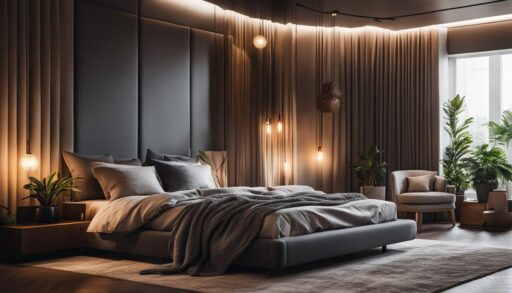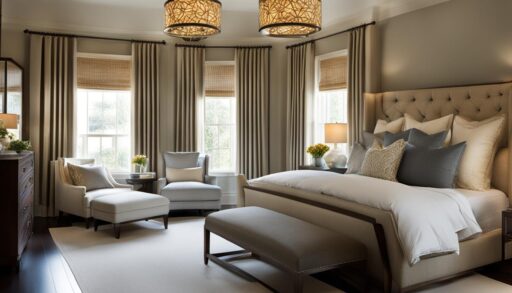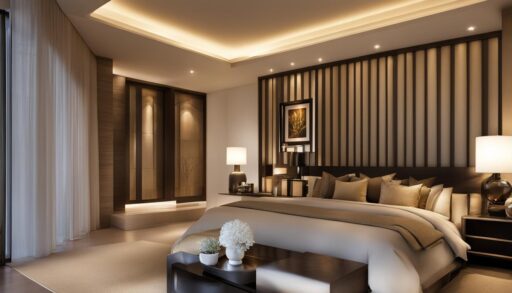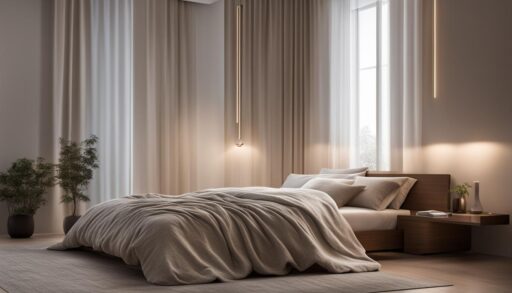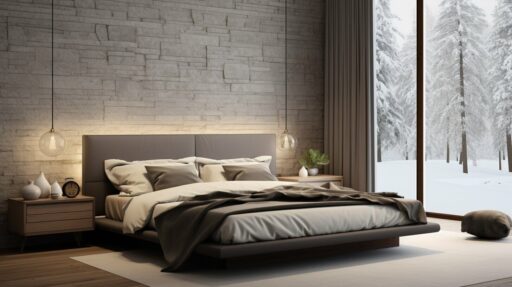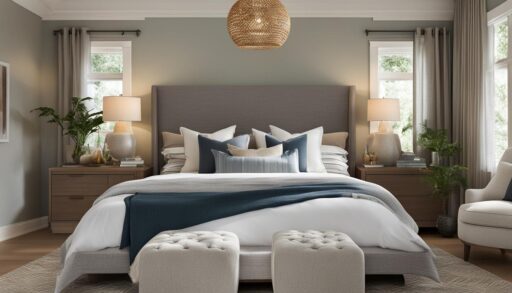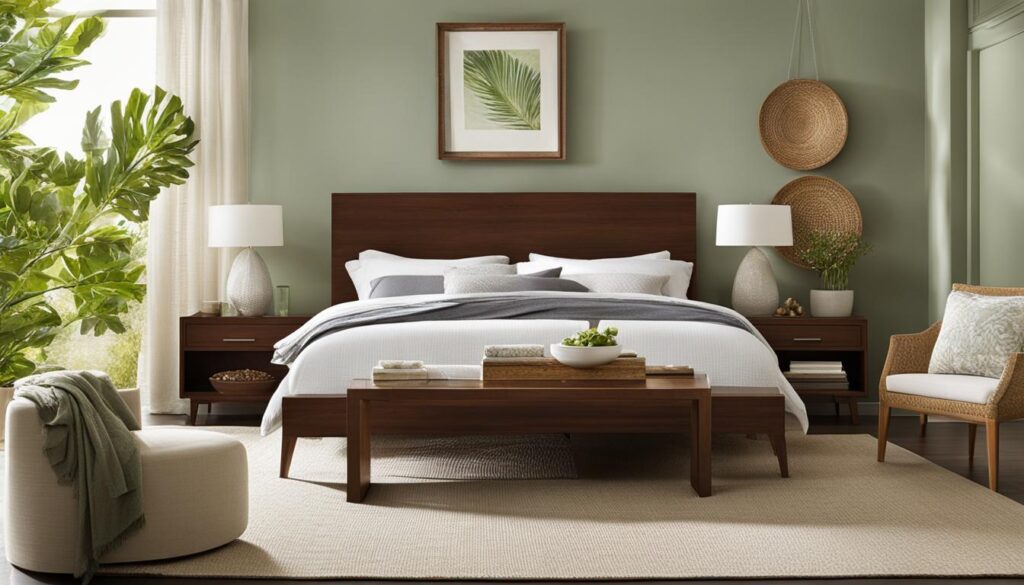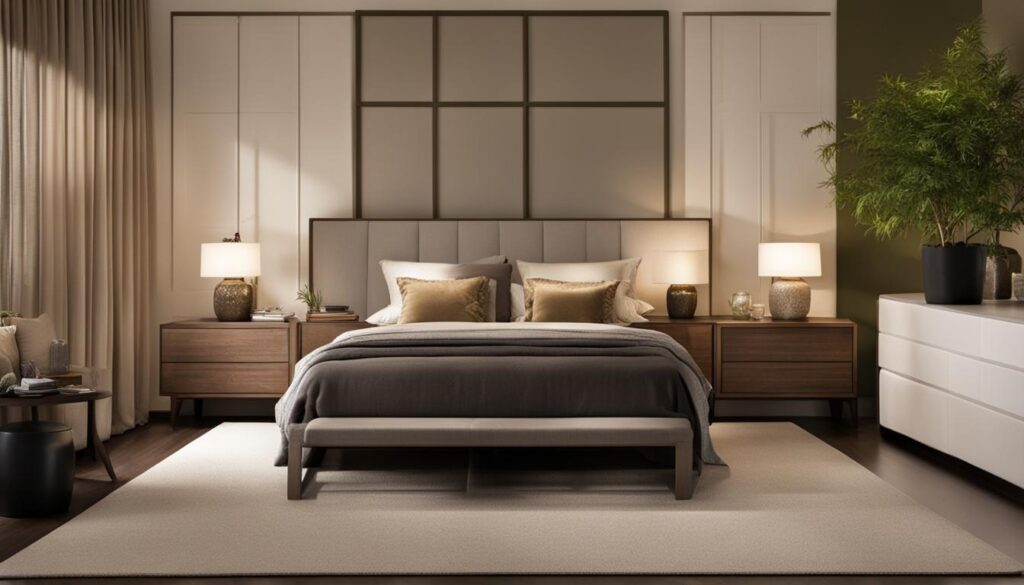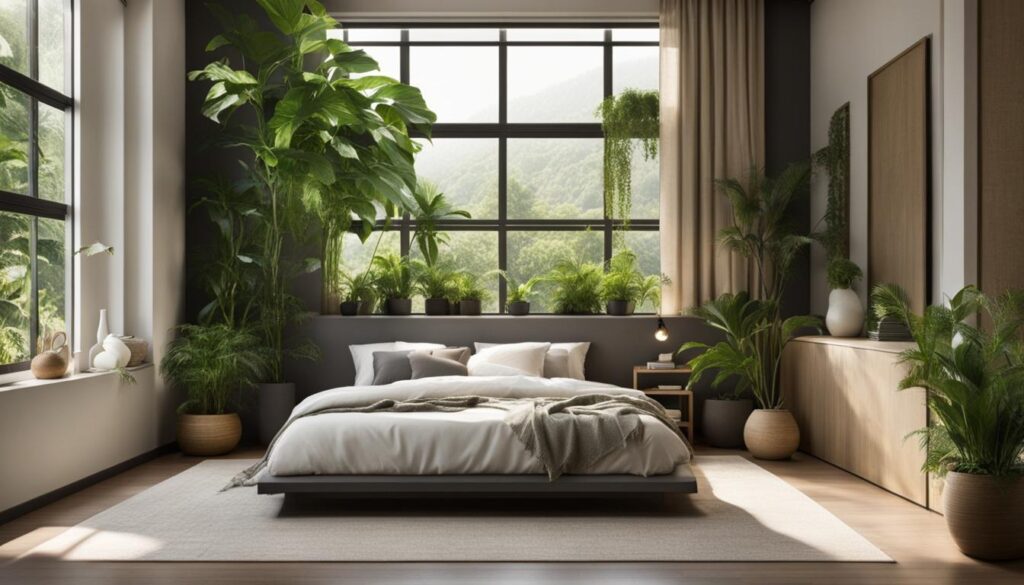Effective Bedroom Soundproofing Tips for a Quiet, Peaceful Room

Your bedroom is meant to be a sanctuary where you can relax and unwind. However, unwanted noises from outside or within your home can disturb your peace and compromise the quality of your sleep. In this section, we will explore various tips and techniques for soundproofing your bedroom to create a serene environment.
Key Takeaways:
- Soundproofing your bedroom can help create a peaceful and comfortable space for relaxation.
- Focus on addressing thin walls, doors, floors, and windows, which are common sources of noise infiltration.
- Consider using soundproofing materials, such as Quiet Barrier HD Soundproofing Composite for walls and Impact Barrier QT Flooring Underlayment for floors.
- Double-pane windows, acoustical sound sealant, and thick drapes can significantly reduce noise transmission through windows.
- Additionally, strategically placing furniture, using soft furnishings, and implementing soundproofing foam or blankets can further enhance soundproofing in your bedroom.
Why Soundproof Your Bedroom?
Your bedroom should be a peaceful haven where you can escape the noise and chaos of the outside world. However, without proper soundproofing, unwanted sounds from neighboring apartments, traffic, or even your own household can seep into your sleeping space, disturbing your peace and affecting your sleep quality. That’s why soundproofing your bedroom is essential for creating a serene environment that promotes relaxation and restful sleep.
There are several reasons why soundproofing your bedroom is important. Firstly, it helps block out external noises that can disrupt your sleep. Whether it’s the sound of cars passing by, construction work, or loud neighbors, a soundproofed room acts as a barrier, reducing the impact of these disturbances and allowing you to enjoy a more tranquil atmosphere.
Secondly, soundproofing prevents your own noise from traveling beyond the confines of your bedroom. If you enjoy playing music, practicing a musical instrument, or simply watching movies late at night, soundproofing can help contain the noise within your space, minimizing the likelihood of disturbing others in your home or neighborhood.
“Soundproofing your bedroom not only helps you sleep better but also enhances your overall well-being. By creating a peaceful and quiet environment, you can wake up feeling refreshed and rejuvenated, ready to take on the day.”
Additionally, soundproofing your bedroom has psychological benefits. A calm and quiet environment promotes relaxation, reduces stress levels, and improves mental clarity. It allows you to escape the constant noise pollution of modern life, encouraging a more restorative sleep experience. By investing in soundproofing measures, you are prioritizing your physical and mental well-being and creating a space that truly supports your sleep and relaxation needs.
| Benefits of Soundproofing Your Bedroom | Reasons to Soundproof Your Bedroom | Importance of Bedroom Soundproofing |
|---|---|---|
| Improves sleep quality | Blocks out external noises | Promotes relaxation and rest |
| Minimizes noise disturbances | Contains your own noise | Reduces stress levels |
| Enhances overall well-being | Creates a tranquil atmosphere | Improves mental clarity |
Soundproofing Methods for Bedroom Walls
Your bedroom should be a haven of peace and tranquility, free from the disturbances of the outside world. However, thin walls can easily allow noise to penetrate into your personal sanctuary, disrupting your sleep and relaxation. To combat this issue, there are several effective methods for soundproofing your bedroom walls.
1. Adding Mass with Soundproofing Materials
One of the most effective ways to reduce noise transmission through walls is by adding mass. Soundproofing materials, such as the Quiet Barrier HD Soundproofing Composite, can be installed on your bedroom walls to help dampen the sound. These materials are specifically designed to absorb and block noise, creating a quieter environment.
2. Hanging Rugs or Rubber Mats
Another simple and cost-effective method for soundproofing bedroom walls is by hanging rugs or rubber mats. These soft, dense materials can absorb and reduce the impact of unwanted sounds, minimizing noise transmission through the walls. Consider selecting rugs or mats with a thick pile or opting for soundproofing-specific products for optimal results.
3. Sealing Gaps and Cracks
Gaps and cracks in your bedroom walls can provide a pathway for noise to enter or escape. By sealing these openings with acoustic sealant or caulk, you can effectively block sound from passing through. Pay close attention to areas around windows, electrical outlets, and baseboards, as these are common areas where sound can leak in or out.
| Soundproofing Method | Effectiveness | Cost |
|---|---|---|
| Adding Mass with Soundproofing Materials | High | Medium-High |
| Hanging Rugs or Rubber Mats | Medium | Low |
| Sealing Gaps and Cracks | Medium | Low |
While each soundproofing method has its own level of effectiveness and cost, a combination of these techniques can provide the best results. Assess your specific needs and budget to determine the most suitable approach for your bedroom walls.

By implementing soundproofing methods for your bedroom walls, you can create a quieter and more peaceful sleeping environment. Say goodbye to the disturbances of outside noise and enjoy restful nights in your personal sanctuary.
Controlling Noise From Doors and Floors
When it comes to soundproofing your bedroom, addressing noise from doors and floors is essential. Gaps at the bottom of doors can allow sound to seep in or out, disrupting your sleep. To effectively block these gaps, consider installing door sweeps or seals. These simple solutions can significantly reduce noise transmission and create a quieter environment.
Floors, especially those made of hard materials like wood or tile, can produce noise from footsteps or other impact sounds. To minimize this, you can use protective underlayment such as the Impact Barrier QT Flooring Underlayment. This material helps dampen noise and provides an additional layer of insulation, enhancing the soundproofing of your bedroom.
By focusing on doors and floors, you can further enhance the overall soundproofing of your bedroom. Keep in mind that small adjustments and additions can make a big difference in creating a peaceful and quiet environment for a restful sleep.
Door Soundproofing Methods
Here are some effective methods to soundproof your bedroom door:
- Install door sweeps or seals to block gaps at the bottom of the door.
- Use weatherstripping tape or adhesive foam tape to seal the sides and top of the door.
- Place a draft stopper or door snake at the base of the door for added insulation.
Floor Soundproofing Techniques
To reduce noise transmission through your bedroom floor, consider these techniques:
- Use rugs or carpeting to add cushioning and absorb impact sounds.
- Apply soundproofing underlayment, such as the Impact Barrier QT Flooring Underlayment, before installing new flooring.
- Place furniture strategically to minimize vibrations and dampen noise.
By implementing these door and floor soundproofing methods, you can create a quieter and more peaceful environment in your bedroom, free from disruptive noises.
Soundproofing Windows for a Quiet Bedroom
Your bedroom should be a peaceful sanctuary where you can escape the noise of the outside world and enjoy restful sleep. However, windows can often be a major source of noise infiltration, allowing traffic sounds or construction noise to disrupt your tranquility. Fortunately, there are several effective techniques to soundproof your windows and create a quieter bedroom environment.
Window Soundproofing Techniques
One effective method is to use double-pane windows, which provide better insulation and absorb more external noise. These windows have two layers of glass with a layer of air or gas in between, creating a barrier against sound transmission. Double-pane windows are available in various styles and can be customized to fit your specific needs.
“Double-pane windows provide better insulation and absorb more external noise.”
In addition to double-pane windows, you can also seal air gaps to further reduce noise transmission. Acoustical sound sealant can be used to seal gaps between the window frame and the wall, preventing noise from entering your bedroom. Additionally, adding insulation tape to the window frame can help block sound waves from penetrating through the window.
How to Soundproof Windows
When it comes to soundproofing windows, it’s important to consider the type of noise you’re trying to block. If the noise is primarily low-frequency, such as traffic rumble, using thick drapes can help absorb and dampen the sound. Hanging heavy curtains over your windows can not only enhance the aesthetic of your bedroom but also provide an effective sound barrier.
For high-frequency noise, such as voices or music, using soundproofing panels or acoustic foam can be beneficial. These materials absorb sound waves and reduce their reflection, helping to create a quieter environment.
By implementing these soundproofing techniques for your windows, you can significantly reduce noise transmission and create a peaceful retreat in your bedroom.
https://www.youtube.com/watch?v=VAyZBphPxoo
Additional Tips for Bedroom Soundproofing
Aside from focusing on the main areas of soundproofing like walls, doors, floors, and windows, there are several additional tips that can further enhance the tranquility of your bedroom.
Strategically placing furniture can make a significant difference in sound absorption. Consider positioning large dressers or bookshelves against noisy walls to help dampen sound and minimize reverberation.
Adding soft furniture, such as plush chairs or a cozy sofa, can also help absorb sound in an empty room. Additionally, placing area rugs on the floor can further dampen noise and create a more peaceful ambiance.
If you’re looking for a more comprehensive solution, consider renovating your bedroom with soundproofing materials like isoTRAX™ systems or Quiet Batt® insulation. These innovations can provide excellent sound deadening and create a haven of tranquility.
For a budget-friendly option, you can utilize soundproofing foam or blankets. These can be easily installed on walls or windows to help reduce noise transmission. They are also portable, allowing you to customize the soundproofing in your bedroom as needed.
Bedroom Soundproofing
- Bob Vila: www.bobvila.com
- Homes & Gardens: www.homesandgardens.com
- The Home Depot: www.homedepot.com

